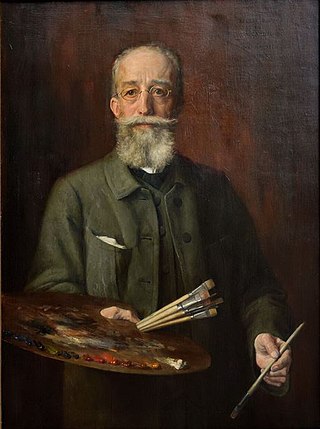
Raffael Hans Ulrich Schuster-Woldan (7 January 1870, Striegau - 13 December 1951, Garmisch-Partenkirchen) was a German painter and art professor; associated with the Munich Secession.

Raffael Hans Ulrich Schuster-Woldan (7 January 1870, Striegau - 13 December 1951, Garmisch-Partenkirchen) was a German painter and art professor; associated with the Munich Secession.

He was the youngest of three children born to Heinrich Schuster , a Court Councilor, and his wife Clara née Seifart. In 1887, he left the local gymnasium without graduating, and followed his older brother, Georg to Munich, where they took lessons at the private art school operated by Frank Kirchbach. In 1889, he accompanied Kirchbach on visits to Frankfurt and Paris. As an addition to his studies, he visited the workshops of other artists. He was also influenced by the Rembrandt etchings he saw at the Münchner Kupferstichkabinett. During this time, he adopted the pseudonym "Woldan", from his father, who had used it to publish a volume of poetry. [1]
After completing his studies, he settled in Dinkelsbühl, but soon moved to Rothenburg, where he began working en plein aire. Feeling the need for improvement, he went to Munich, where he enrolled at the Academy of Fine Arts to study nature painting with Gabriel von Hackl. He took his first study trip to Italy in 1891; experimenting with religious motifs in his landscapes. While in Florence, he became a member of the German-founded Art History Institute. [2]
His first major showing was at the Glaspalast in 1893, where he was nominated for a gold medal. Three years later, he was awarded one there. He also won a gold medal at the Saint Louis Exposition of 1897. At the suggestion of the art historian, Wolfgang von Oettingen , he entered a competition to select an artist for ceiling paintings at the Reichstag building. [3] He was one of three selected. Much of the work was done in Munich; creating canvases that would be set into the ceiling. In 1904, he moved to Berlin to see his commission through to its completion and dedication, which took place in 1911, and he would live there until 1941. [1] He was appointed a Professor of Composition at the Prussian Academy of Art shortly after the dedication; a position he held until 1920. He was named a full member of the academy in 1914. [4]
Following the rise of the Nazis, his older, sometimes mythological styles found favor with the party's supporters, and he was commissioned to do several female portraits. These included Winifred Wagner, Cosima Wagner and Emmy Göring. [5] He was awarded the Goethe-Medaille für Kunst und Wissenschaft in 1940, and his works were featured at the Große Deutsche Kunstausstellung of 1941. Hitler bought one for 60,000 ℛ︁ℳ︁. [4] Shortly after, he moved to the safety of a remote location in Bavaria where he died, ten years later.
Conrad Hommel was a German painter. He was best known for his portraits of leading German entrepreneurs such as Max Grundig, Herbert Quandt, and politicians such as Adolf Hitler, Hermann Göring and Paul von Hindenburg.

Johann Peter Theodor Janssen was a German historical painter.

Josef Bernhard Maria Bleeker was a German sculptor.
Hans Tichy was an Austrian artist and a professor at the Academy of Fine Arts, Vienna.

Rudolf Otto von Ottenfeld was an Austrian military painter, a founding member of the Vienna Secession and a professor at the Academy of Fine Arts, Prague.
Wilhelm Schmidthild was a German painter, graphic artist, illustrator and art professor. He chose as his field detailed documentation as an illustrator for botanical and zoological reference books and free compositions in the tradition of realism. He is also known as Schmidt-Hild.

Oskar Frenzel was a German landscape-artist, animal painter and lithographer.
Emmy Lischke (1860-1919) was a German painter known for her landscapes and still lifes.
Hans Schmitz-Wiedenbrück was the alias of Hans Schmitz was a German painter of sacral, peasant and Nazi propaganda arts. He belonged to the Wiedenbrücker Schule school of arts.

Carl Frithjof Smith was a Norwegian portrait and genre painter who spent his career in Germany.

Julius Victor Carstens was a German painter. He worked in a variety of genres; including portraits, landscapes and still-lifes. He also painted a few church interiors.

Friedrich Schaarschmidt was a German landscape painter and figure painter of the Düsseldorf school of painting, conservator and art writer.
Karl Krug was a German painter.
Wolfgang Hütt was a German art historian.

Mathilde Block was a German painter and embroiderer. Her artworks and paintings range from pencil portraits to embroidered quilts and have been exhibited in numerous art expositions throughout the world.
Ferdinand Lepcke (or Lepke) (1866–1909) was a German sculptor, who in particular realized two major monuments in Bydgoszcz: the Deluge Fountain and The Archer. He received a golden medal at the Great Berlin Art Exhibition and, the Berlin Minister for Spiritual Education and Medical Affairs awarded him the title of professor.
Fred Kocks in Düsseldorf was a German landscape and figure painter, draughtsman and lithographer as well as curator, museum director and author.

Josef Flossmann was a German sculptor; associated with the Munich Secession.

Georg Paul Schad, known as Paul Schad-Rossa was a German painter and sculptor, in the Symbolist style.
The Große Deutsche Kunstausstellung was held a total of eight times from 1937 to 1944 in the purpose-built Haus der Deutschen Kunst in Munich. It was representative of art under Nazism.
